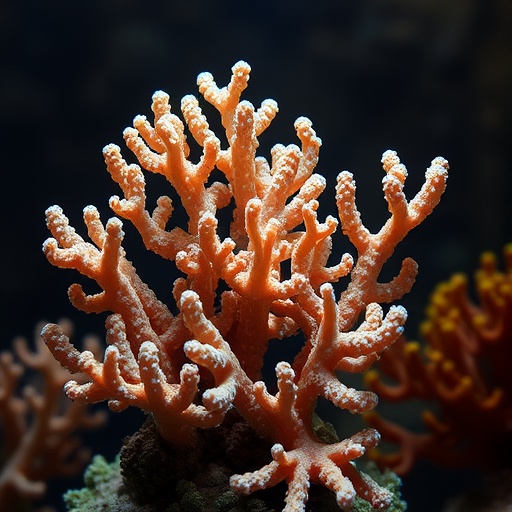Coral Reefs Reveal a Revolutionary Light-Sensing Mechanism Using Chloride Ions
Coral reefs, often thought to be passive and simple marine organisms, harbor a sophisticated biological secret that rewrites the textbook on how animals perceive light. A collaborative research effort led by scientists at Osaka Metropolitan University has unveiled a groundbreaking discovery about the unique light detection system within reef-building corals. Their study reveals that these corals utilize a novel mechanism involving chloride ions to modulate their vision sensitivity, raising profound implications for our understanding of photoreception in the animal kingdom and opening new frontiers in bioengineering.
Unlike organisms equipped with complex eyes, corals rely on light-sensitive proteins called opsins to interpret their luminous environment. Opsins typically function by binding to a molecule called retinal, which absorbs ultraviolet (UV) light intrinsically. For most animals, extending this UV sensitivity into the visible spectrum requires retinal to form a specialized chemical linkage known as a Schiff base within the opsin protein. This linkage carries a positive charge, stabilized by a nearby negatively charged amino acid, called a counterion. This carefully balanced electrostatic relationship is essential for the pigment’s ability to absorb varied wavelengths, enabling a broad palette of light perception.
However, anthozoans—specifically reef-building corals and sea anemones—possess a distinct subset of opsins termed the anthozoan-specific opsin II group (ASO-II). These ASO-II opsins intriguingly lack the conserved counterion amino acids universally seen in other animal opsins. This conundrum prompted Professor Akihisa Terakita and his colleagues to investigate how corals maintain functional light sensitivity without these canonical amino-acid counterions. The absence of these typical stabilizing residues suggested corals might employ an unprecedented counterion strategy, which had not been observed in any other animals.
Focusing on the reef-building species Acropora tenuis, the team utilized a comprehensive approach that combined mutational experiments, spectroscopy, and advanced computational simulations to unravel this mystery. Astonishingly, the researchers discovered that ASO-II opsins do not use amino acids as counterions at all. Instead, they recruit chloride ions (Cl⁻) from their external environment to stabilize the positively charged Schiff base. This is the first documented occurrence of opsins employing inorganic ions rather than organic amino acids to modulate spectral sensitivity.
This novel chloride-mediated counterion function affords the corals several adaptive advantages. Chloride ions inherently stabilize the Schiff base less firmly than amino acid residues, permitting the opsin to reversibly switch its wavelength sensitivity depending on the environmental pH. At lower pH values—corresponding to more acidic conditions—the protonated Schiff base adopts a positive charge that is stabilized by chloride, shifting light absorption toward longer wavelengths within the visible spectrum. Conversely, at higher pH values, the Schiff base remains deprotonated, favoring UV light sensitivity. This elegant pH-dependent switchability is unprecedented in opsin biology and highlights a dynamic photosensory system finely attuned to coral cellular environments.
The pH fluctuates naturally within coral tissues, primarily influenced by the photosynthetic activity of their endosymbiotic algae. These symbiotic dinoflagellates generate nutritional sugars for the coral host while also altering cellular pH through their metabolic functions. The chloride-mediated spectral tuning of ASO-II opsins likely provides a mechanism by which corals can adjust their light sensitivity in real time, responding dynamically to the biochemical changes induced by their symbionts. This insight dramatically deepens our understanding of coral-algae symbiosis, illuminating how photoreceptive processes are integrated with metabolic interactions.
From a biophysical perspective, the discovery challenges long-held assumptions about opsin architecture and photoreceptor chemistry. The role of inorganic ions as functional counterions expands the molecular toolkit available to photoreceptors across species. This finding invites reconsideration of opsin evolution, suggesting that coral opsins represent an ancient or parallel adaptation wherein inorganic ions substitute for amino acid residues to fulfill critical electrostatic roles in light detection proteins.
Beyond evolutionary biology, this discovery carries exciting prospects for bioengineering and optogenetics—the use of light-sensitive proteins to control cellular processes with spatial and temporal precision. The researchers demonstrated that the ASO-II opsin of Acropora tenuis regulates calcium ion fluxes in a light-dependent manner, with its spectral sensitivity modulated by pH. Such a characteristic could be exploited to create novel optogenetic tools capable of switching wavelength sensitivity dynamically, providing a versatile platform for controlling cellular signaling pathways in complex biological systems.
The Osaka Metropolitan University team’s research, published in the journal eLife, not only spotlights a remarkable adaptation in one of the planet’s most ecologically vital organisms but also sets a precedent for discovering alternative photoreceptor mechanisms in nature. These insights will likely propel new inquiries into marine photosensory biology, the interplay between environmental factors and sensory systems, and innovative designs for light-controllable biomolecules.
This discovery is a vivid reminder that even seemingly simple organisms like corals possess a rich repertoire of molecular strategies to interface with their environment. The ability to harness inorganic ions for photoreception reflects both the evolutionary ingenuity and biochemical flexibility that underpins life’s capacity to adapt to diverse ecological niches. As coral reefs face escalating environmental pressures, understanding their biology at this granular molecular level may be critical to their conservation and the sustainability of the ecosystems they support.
The implications of this research extend broadly, encompassing molecular biology, marine ecology, evolutionary science, and biotechnology. Coral anthozoan-specific opsins leveraging chloride ions as counterions expand the paradigm of photoreceptive function and reveal a remarkable example of nature’s adaptive versatility. As researchers continue to investigate the myriad ways organisms perceive and respond to light, coral reefs remind us of the hidden complexity beneath their colorful surfaces—complexity that holds promise for science and society alike.
Subject of Research: Cells
Article Title: Coral anthozoan-specific opsins employ a novel chloride counterion for spectral tuning
News Publication Date: 1-Sep-2025
Web References: http://dx.doi.org/10.7554/eLife.105451.3
Image Credits: Osaka Metropolitan University
Keywords: reef-building corals, opsins, chloride ions, photoreception, spectral tuning, anthozoan-specific opsins, Schiff base, pH-dependent sensitivity, coral symbiosis, optogenetics, light-sensitive proteins, evolutionary biology
Tags: animal vision without eyesbioengineering applications in coralsbreakthroughs in marine sciencechloride ions in coralscoral reef ecosystemscoral reef light sensingelectrostatic interactions in opsinsmarine biology researchnovel photoreception mechanismsopsins and light perceptionreef-building coral adaptationsUV light sensitivity in corals





